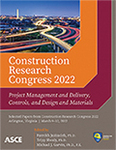Collaborative Planning Metrics in Construction Projects: A Factor Analysis Approach
Publication: Construction Research Congress 2022
ABSTRACT
Adversarial relationships between different construction stakeholders have been one of the main causes of poor performance in projects. As such, collaborative planning has been presented which promotes active involvement and integration between the various parties to a project. Previous research concentrated on specific facets of collaborative planning and lacked offering a broad study of the underlying factors affecting construction collaborative planning. This paper tackles this point. As such, the authors distributed a survey to industry experts for evaluating a holistic list of 50 collaborative planning metrics. Utilizing factor analysis on the retrieved survey data of 53 responses, the authors concluded that 35 metrics can be extracted and grouped into five categories, namely, behaviors, planning, procurement, technology, and lean construction. The research findings highlight the intercorrelation of the studied metrics and thus offer practitioners with enhanced understanding of the factors influencing construction collaborative planning. Ultimately, successfully employing collaborative planning in construction projects will enhance the performance in terms of enhancing productivity, reducing cost and schedule overruns, and fostering a more collaborative work environment.
Get full access to this article
View all available purchase options and get full access to this chapter.
REFERENCES
Ballard, H. G. (2000). The last planner system of production control (Doctoral dissertation, University of Birmingham).
Bayhan, H. G., Demirkesen, S., and Jayamanne, E. (2019). “Enablers and Barriers of Lean Implementation in Construction Projects.” IOP Conference Series: Materials Science and Engineering, IOP Publishing, 471(2), 022002.
Bhawani, S., Messner, J., and Leicht, R. (2020). Developing an Ontology for Implementation of Lean Construction Methods in Construction Projects. In Construction Research Congress 2020: Project Management and Controls, Materials, and Contracts (pp. 427–435). Reston, VA: American Society of Civil Engineers.
Chen, L., Lu, Q., Li, S., He, W., and Yang, J. (2021). Bayesian Monte Carlo Simulation–Driven Approach for Construction Schedule Risk Inference. Journal of Management in Engineering, 37(2), 04020115.
Chen, W. T., and Chen, T.-T. (2007). “Critical success factors for construction partnering in Taiwan.” International Journal of Project Management, 25(5), 475–484.
Costa, F., Denis Granja, A., Fregola, A., Picchi, F., and Portioli Staudacher, A. (2019). “Understanding Relative Importance of Barriers to Improving the Customer–Supplier Relationship within Construction Supply Chains Using DEMATEL Technique.” Journal of Management in Engineering, 35(3), 04019002.
Dainty, A., Moore, D., and Murray, M. (2006). Communication in construction: Theory and practice. Taylor and Francis, London and New York.
Daniel, E., Christine, P., and Dickens, G. (2019). “Development of Approach to Support Construction Stakeholders in Implementation of the Last Planner System.” Journal of Management in Engineering, 35(5), 04019018.
Deep, S., Gajendran, T., and Jefferies, M. (2019). “A systematic review of ‘enablers of collaboration’ among the participants in construction projects.” International Journal of Construction Management, 0(0), 1–13.
Durdyev, S., and Mbachu, J. (2018). Key constraints to labour productivity in residential building projects: Evidence from Cambodia. International Journal of Construction Management, 18(5), 385–393.
Elsayegh, A., and El-Adaway, I. H. (2021a). Holistic Study and Analysis of Factors Affecting Collaborative Planning in Construction. Journal of Construction Engineering and Management, 147(4), 04021023.
Elsayegh, A., and El-Adaway, I. H. (2021b). Collaborative Planning Index: A Novel Comprehensive Benchmark for Collaboration in Construction Projects. Journal of Management in Engineering, 37(5), 04021057.
Elsayegh, A., El-Adaway, I. H., Assaad, R., Ali, G., Abotaleb, I., Smith, C., Bootwala, M., and Eteifa, S. (2020). Contractual Guidelines for Management of Infrastructure Transportation Projects. Journal of Legal Affairs and Dispute Resolution in Engineering and Construction, 12(3), 04520023.
Faris, H., Gaterell, M., and Hutchinson, D. (2019). “Investigating underlying factors of collaboration for construction projects in emerging economies using exploratory factor analysis.” International Journal of Construction Management, 0(0), 1–13.
Field, A. (2009). Discovering statistics using SPSS, Sage, Thousand Oaks, CA.
Franz, B., and Messner, J. (2019). Evaluating the impact of building information modeling on project performance. Journal of Computing in Civil Engineering, 33(3), 04019015.
Hanna, A. S. (2016). “Benchmark Performance Metrics for Integrated Project Delivery.” Journal of Construction Engineering and Management, 142(9), 04016040.
Koolwijk, J. S. J., van Oel, C. J., Wamelink, J. W. F., and Vrijhoef, R. (2018). Collaboration and integration in project-based supply chains in the construction industry. Journal of Management in Engineering, 34(3), 04018001.
Lai, H., Deng, X., and Chang, T.-Y. P. (2019). “BIM-Based Platform for Collaborative Building Design and Project Management.” Journal of Computing in Civil Engineering, 33(3), 05019001.
Ling, F. Y., Teo, P. X., Li, S., Zhang, Z., and Ma, Q. (2020). Adoption of Integrated Project Delivery Practices for Superior Project Performance. Journal of Legal Affairs and Dispute Resolution in Engineering and Construction, 12(4), 05020014.
Rad, S. K., and Kermanshachi, S. (2018). Development of Project Life Cycle Communication Ladder Framework Using Factor Analysis Method. In Proceedings of Construction Research Congress (pp. 2–4).
Sage Publication. (2000), Field Discovering statistics using SPSS for windows: advance techniques for the beginner, Great Britain.
Shelbourn, M., Bouchlaghem, N. M., Anumba, C., and Carrillo, P. (2007). “Planning and implementation of effective collaboration in construction projects.” Construction Innovation, 7(4), 357–377.
Tafazzoli, M., and Shrestha, P. (2017). Factor analysis of construction delays in the US construction industry. In International Conference on Sustainable Infrastructure (111–122).
Yong, A. G., and Pearce, S. (2013). A beginner’s guide to factor analysis: Focusing on exploratory factor analysis. Tutorials in Quantitative Methods for Psychology, 9(2), 79–94.
Information & Authors
Information
Published In
History
Published online: Mar 7, 2022
Authors
Metrics & Citations
Metrics
Citations
Download citation
If you have the appropriate software installed, you can download article citation data to the citation manager of your choice. Simply select your manager software from the list below and click Download.
